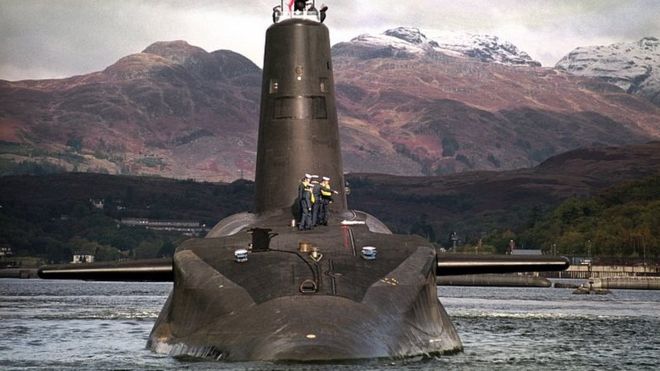British Nuclear Weapons Part 3: Trident
 |
| Via BBC |
Origins
In 1980, the government made the decision to obtain a Trident C4 missile system to begin replacing Polaris. In 1982, the decision was made to instead obtain a D5 missile which was financially beneficial for Britain since it was the same missile used by the US Navy. The 1958 Mutual Defence Agreement and the 1963 Polaris Sales Agreement allow Britain to procure Trident missiles from the US at a lower cost whilst retaining British nuclear independence.
From 1994, 4 Vanguard-class submarines which carried Trident missiles slowly replaced the Resolution-class submarines, ending the Polaris/Chevaline systems. The Polaris era officially ended on 28 August 1996.
 |
| Image: Danny Lawson/PA via Telegraph HMS Vigilant |
Trident is the nuclear weapons system introduced after the Polaris/Chevaline systems. The Defence Council considered whether to replace Polaris with surface to air missiles, whether to go back to aircraft based deterrent or whether to use a sea launch system from surface ships. However after weighing up the pros and cons, it was evident that submarine based nuclear deterrents were "clearly the best platforms for Britain's future strategic force".
Trident consists of 4 nuclear submarines, each of which carries up to 8 missiles. Each submarine is actually capable of carrying 16 missiles but it was decided in 2010 to not use the full capacity. Each missile carries 5 nuclear warheads. The Trident II D5 has a range of approximately 4600 miles. One Trident submarine is on patrol at all times. The Vanguard submarines are twice the size of their predecessors.
It is estimated that each warhead is 8 times as destructive as the bomb used at Hiroshima in 1945.
Each submarine also carries a sealed letter of last resort, written by the Prime Minister containing instructions on what action to take if the UK has been destroyed by a nuclear strike and the government wiped out.
Replacing Trident
Although the Trident system will continue for years to come, it will not last indefinitely and a replacement could take up to 17 years to develop. In 2016 it was announced that Trident's replacement would be 'Successor' and the next submarines will be 'Dreadnought Class'. Construction began in September 2016. Each sub can carry up to 12 missiles and will utilise the previous Trident D5s. It is estimated that the new Dreadnought subs will cost £31 billion to build, test and commission over the next 35 years. However, not everybody agrees that Trident should be replaced and some argue that perhaps the British nuclear deterrent force should be completely scrapped.
Arguments for Replacing Trident
The general stance for continuing a nuclear deterrent force lay in the idea that there is an 'uncertain future' ahead. It is unclear whether there will be a re-emergence of nuclear threats to the UK in the future. In such an uncertain environment, some believe that Britain needs to keep its options open.
The nuclear defence industry also employs approximately 15,000 people and scrapping a nuclear defence strategy would see many people lose their jobs.
Arguments for Not Replacing Trident
The case for not replacing Trident is also quite convincing.
As CND accurately point out, the government fail to identify exactly what it is the deterrents are protecting us from. The government publication regarding Trident specifically notes that "the nuclear deterrent is not intended to deter terrorists" but rather it is " to deter the most extreme threats to our national security and way of life, which cannot be done by other means".
Is 'to deter threats' a convincing enough argument to spend at least £31 billion on a project that, if actually used, would kill thousands of civilians?
Will there ever be nuclear disarmament?
The UK is part of the Non Proliferation of Nuclear Weapons Treaty which was signed by 191 states and committed the UK to the long term goal of total nuclear disarmament. Britain have reduced their nuclear force by over half since the Cold War and have also reduced the number of warheads from 48 to 40 per submarine since 2010 and have limited the number of missiles to 8 per submarine. Is this enough?
Do you think Trident should be replaced or scrapped?
Further Reading:
The History of the UK's Nuclear Weapon Programme https://assets.publishing.service.gov.uk/government/uploads/system/uploads/attachment_data/file/27383/Cm6994_Factsheet5.pdf
Trident Nuclear Weapons https://cnduk.org/resources/trident-nuclear-weapons-system-qa/
The UK's nuclear deterrent: what you need to know https://www.gov.uk/government/publications/uk-nuclear-deterrence-factsheet/uk-nuclear-deterrence-what-you-need-to-know
A guide to trident and the debate about replacement https://www.bbc.com/news/uk-politics-13442735
The Future United Kingdom Strategic Nuclear Deterrent Force http://fc95d419f4478b3b6e5f-3f71d0fe2b653c4f00f32175760e96e7.r87.cf1.rackcdn.com/6AC6FE79AE5E485DB3A2B579B6AE0654.pdf
Great Britain's Nuclear Weapons Could Easily Destroy Entire Countries https://nationalinterest.org/blog/the-buzz/great-britains-nuclear-weapons-could-easily-destroy-entire-22057
Rob Forsyth, Trident: Why I Changed My Mind About the UK's Nuclear Weapons, https://www.oxfordresearchgroup.org.uk/blog/trident-why-i-changed-my-mind-about-the-uks-nuclear-weapon
The Treat on the Non-Proliferation of Nuclear Weapons (NPT) https://www.un.org/disarmament/wmd/nuclear/npt/




